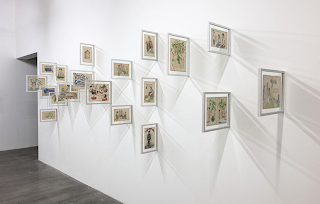Dieter Roth installation view
Think about how you would encounter the Roth installation above. If you wanted to look at each image you would have to walk in between the frames and bend your knees so that you could see the images set out below. Then you would have to rotate around to look at the facing two images. Each encounter would then mean stepping back out of the space, seeing the images fanning out away from you and then you would step back in between the images to look at the next four images. However as you approach the work, the installation would work as an object that rhythmically articulated along the wall. The piece therefore having both an overall physical presence and a series of 'framed' moments that could only be experienced one at a time. You are made to be very aware of having to work hard to see this work, it is a very public encounter, with moments of intimacy in between having to step out into the gallery space to re-orientate yourself. It engages the audience in a way that could be seen as performative. Compare this experience with that of a double sided hinged frame.
John Jones framers: Hinged double sided frame
In the case of a hinged frame you encounter the object flat onto the wall, the initial experience being not dissimilar to the normal one of looking at a framed drawing. However it is subtly different. The frame is more 'object' like as it is much deeper than you would expect. The realisation that you need to do something is triggered by an awareness of the inset hinges and then of course in order to see the other side you need to open the frame as you would a book. You need to peer inside, an action quite different to walking in and around the frames as you do with the Roth piece. This is more about privacy, and intimacy, an effect heightened by the fact that the work is also window mounted, a further frame within a frame, designed to heighten a sense of 'honorific' value, or as Benjamin would put it to frame the 'aura' of the image. However because one image is seen first and then the other side is seen later, after opening up to reveal what is inside, it could also be argued that this type of frame suggests a division such as conscious and unconscious, or revealed and hidden. This type of encounter has a long history, for instance the 'Wilton Diptych' is designed to be opened like a book, you open it to reveal its precious contents. Many altarpieces were designed to be open and closed. Often with one type of image on the outside, sometimes painted in grey, so that when the screen door is opened the colour of the painting inside glows and shines out.
'Wilton Diptych'
19th century American miniature portrait
The small intimate locket type of image such as the one above has been made for many societies over a long period of time and it is this very personal encounter that the hinged frame also suggests.
This is quite different to a freestanding double sided frame, such as the one used to display the work of Max Pechstein below.
Max Pechstein
Imagine this situation. In the 1930s an artist paints a flat geometric 'Modernist' painting. His gallery has it framed in a 'Modernist' frame, a simple clean black box and the painting is bought and is exhibited for many years in a well known art gallery. In the year 2017 a new curator moves into the gallery and has all the Modernist paintings reframed in 19th century style Victorian gilt frames, knowingly re-positioning the works by making us aware that we were always 'seeing' the painting and its frame as an invisible and indivisible relationship.
But do you always have to frame? If you look at Laercio Redondo's work below it has simply been put on small shelves and leant against the wall. Again this makes the images work more as objects, but now without the frame, the image and object begin to fuse.
Laercio Redondo
Hajra Waheed's work also relies for its presentation on long lines of purpose built shelves.
Hajra Waheed
Coda
Since putting up this post Thao Nguyen Phan has has an exhibition at Tate St Ives. She tells complex stories that intertwine mythology and folklore with urgent issues around industrialisation, food security and the environment. The threat posed by the destruction and excessive consumption of Earth’s resources is a recurring theme across her practice and she uses a variety of means to communicate these issues, including drawing. In this case her presentation technique means that you have to encounter the work by walking around it and leaning in awkwardly close to the wall, you can then see both sides of the framed pieces. The very difficulty involved seems to make you remember the issues raised, she is heightening our embodied memory.
See also:
The frame and the screen
Framing a large drawing
The frame and the banner
From drawing to installation
The frame and the screen
Framing a large drawing
The frame and the banner
From drawing to installation
Hanging work for exhibition









No comments:
Post a Comment